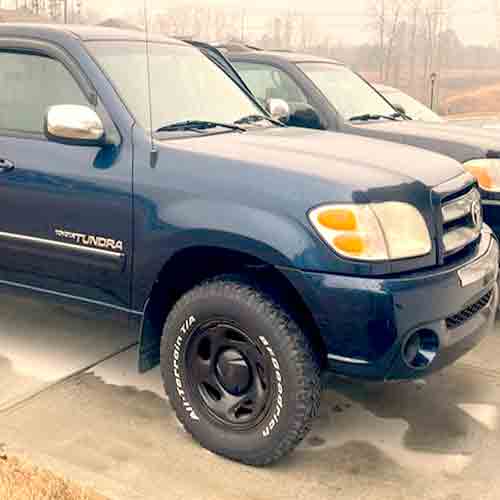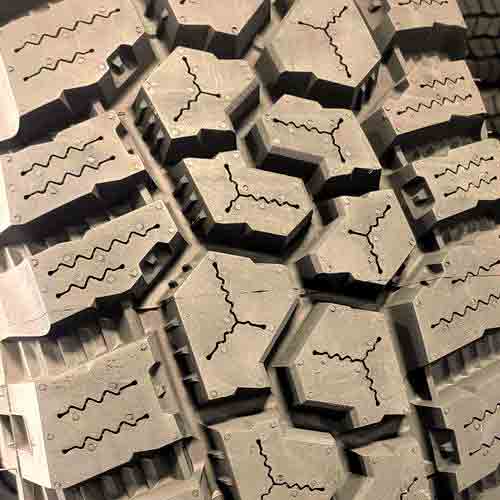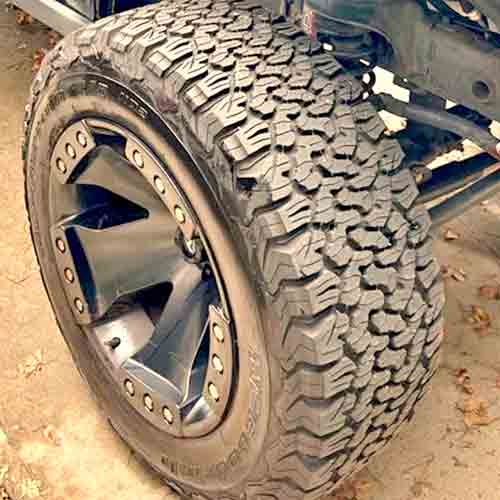The Cooper Discoverer Rugged Trek and the BF Goodrich KO2 are all-terrain tires that bring a lot to the table. They both offer amazing off-road commute while keeping decent on-road manners. Though which of these big players gets the upper hand can get tricky. But let me make things easier for you.

As a seasoned tire engineer, I can tell you that the BF Goodrich KO2 features a better dry grip, fuel economy, tread life, and overall noise reducing capabilities. Whereas the Cooper Rugged Trek does only one thing better on pavements, wet traction, though it mostly shines off-road performing better on mud, gravel and sand. Still, it can’t outperform KO2 on rocky terrains, with lacking durability.
Durability
The demands of challenging terrains require off-road tires to possess a durable build, that’s why they also get to be heavier.
Though its still amazing to see how well the the KO2 balances between the two, meaning, despite it’s solid build of 3 ply polyester casing, it’s still lighter in comparison to the other tire.
The Cooper Rugged Trek on the other side, has only 2 ply polyester carcass construction, and where it’s single cap ply on top is also not helping (the KO2 has 2 plies there, and they are also spirally wound, further adding to the overall toughness).
Recommended Read –
Are A/T tires harder to puncture: https://tiredriver.com/are-all-terrain-tires-harder-to-puncture/
Sizes Info
While the BFG KO2 provides you with 90 sizes, 15 to 22 inches. And all its sizes come with following specs.
- Speed Ratings: R, S, and Q
- Load ratings range: C to E
- Weight range of all sizes: 35 lbs to 67 lbs
- Tread Depth: 15/32″ on all sizes (except for 4)
- Winter ratings: M+S & 3PMSF
- 50k miles warranty
Review this tire here: https://tiredriver.com/bf-goodrich-ko2-review/.
Cooper Rugged Trek offers just 18 sizes in 16 to 20 inches, having following specs.
- Speed ratings: T and Q
- Load ratings: SL, XL, E and F
- Tire weight goes form 40 lbs to 70 lbs
- Tread depth: Either 16/32″ or 18.5/32″
- All sizes have 3pmsfr
- LT sizes have 55k miles warranty, while others have 65k
(Make sure you know, how to read tire sizes).
Tread Structure
The tread of Cooper Rugged Trek is pretty aggressive, so let me start off with this tire (from the middle).

So here blocks are more compacted up. And with this they get to do two things on/off road. Let me explain.
On rugged tracks, these lugs having sharp edges, interlocking sipes, and ridges bite in to all kinds of surfaces.
And on roads, their closeness provide ample surface area of rubber to remain in contact with the road.
Though the tire could use a little wet traction, even with those Y shaped sipes.
Moving towards sides, the tread becomes more aggressive, so although lateral grip on highways gets to be limited a bit, its not much, as these lugs have supports underneath.
These supports yeild on road stability and at the same time act as stone ejectors.
Moreover the outer edges are also very powerful with mud scoops and sharp biters on sidewalls, giving amazing traction values on all terrains, may it be rocks, sand or even mud.
On the other side, we have a beast of a tire, the BF Goodrich KO2.

This tire features relatively smaller blocks in the middle. They are all worm shaped, have full depth notches and sipes to them which split open as the lugs flex.
So with that you get to have amazing off-road capabilities, whereas the tire also does not compromise on road with the consistent design these lugs make. Though the tire could use some wet traction as those sipes aren’t that effective over there.
Moving towards the shoulders, the lugs get to be much more aggressive here.
They are staggered, have prominent mud scoops and joined up sidewall lugs. All of these ensure the tire stays intact off-road in all types of terrains.
Moreover, adding to overall aggressiveness are the angles cuts on these lugs, enhancing biting abilities, especially with lowered air pressure values.
For Your Info: The interlocking pattern of the KO2 is since very inviting of dirt particles, the tire is given with dual stone ejectors to fight against that.
Dry Traction
The dry performance of an all-terrain tire can only be properly assessed, through a technical examination of its directional/lateral traction, steering, and cornering characteristics.
Let’s check them all out one by one.
Dry Grip
Dry grip also known as directional grip is calculated by braking distances, and tire’s accelerating capabilities. And as this grip gets calculated while moving straight, it highly depend on the central part of the tread.
That’s why both tires, provide above average traction abilities here. Though still, the BF Goodrich KO2 is a little better, as it’s full depth sipes are very helping here. Ironically, these sipes, help more in dry than on wet, (as you’ll see). They split open the lugs all the way, and they get to grab the tar surface with more friction.
The Cooper Rugged Trek on the other side, is although closed up form the middle (part of the tread), it’s lateral grooves are still wider, and account for inconsistent rubber’s connection with the road.
Lateral Traction
The tire’s lateral traction (during cornering) is largely influenced by it’s ability to meet up with the ground form shoulders. This is because during turns, the whole weight shifts towards the edges on the tire.
That’s why with such open structure, the Cooper Discoverer Rugged Trek is very lacking here.
BF Goodrich KO2 on the other side, although also features pretty aggressive shoulder lugs as well, it still able to provide a good enough lateral efficacy, thanks to it’s prompting steering response. Let me explain.
Steering Response
There’s always a gap between the steering input generated by the driver, and the wheels feedback. And it highly depends on the thread flexibly.
During cornering, the lugs on off-road/all-terrain tires, try to bend in the opposite direction (of the lateral force), and with a more flexible compound, and larger tread depth, it gets worsened.
That’s why Cooper Rugged Trek with more weight, softer tread composition, and deeper tread voids, gets to be slower. Whereas the BF Goodrich KO2 with it’s dual compound (hard rubber underneath, providing foundational support), get to provide better steering feedback, and overall handling as a result.
Wet Traction
The overall wet capability of a tire depends on how better it is at evacuation water out of the tread. And it does that with two things, sipes and grooves.
Grooves expel out a majority of the water out, while the sipes deal with it at a micro level. These sipes basically create vacuum in their slits which absorbs the water up, clearing the tire’s path.
The BF Goodrich KO2 although provides great hydroplaning resistance (clearing water from grooves, it’s sipes are too stiff to properly flex and clear water away). That’s why in comparison the Cooper Discoverer Rugged Trek is taking the lead.
Tread Life
The same factors that affect the fuel on the tire, affects tire’s longevity.
The softer compound of Cooper Discoverer Rugged Trek, rubs off the surface with more friction, and burns faster, despite deeper tread voids (which increases the time for a tire to completely wear off).
BF Goodrich KO2 on the other side, with dual compound, featuring harder tread composition, gives a lot more mileage in comparison.
Fuel Efficiency
The fuel efficiency of a tire is affected by its rolling resistance, (which can be influenced by the tire’s weight and tread composition too).
And Cooper Rugged Trek provides features which generate much more of it in comparison. The tire’s heavier weight put more pressure on the lugs, as the rub off with the surface (they are on), with greater force, and it’s softer compound is more stickier.
That’s why comparatively, you get a better fuel efficiency on BFG KO2. This tire with less flexing tread does not waste energy in to bending of the lugs, and that energy is used more in to rolling the tire, instead.
Ride Quality
A tire’s ride quality is influenced by factors such as noise level, comfort, and its ability to absorb road impacts. I discussed all of them below.
Comfort
Though the Cooper Rugged Trek may lose some ride quality with it’s balder design, it’s softer tread still provides better absorption of the bumps, both on and off-road.
The BF Goodrich KO2 on the other hand feels jittery, especially on corners, as the tire’s with spirally wound nylon cap plies account for very stiff sidewalls and shoulder lugs, and they don’t provide better settling down to the on-road vibrations.
Quietness of Ride
Noise is produced by moving air, and here the overall structure of the tire influences it a lot, as the tread voids, composition, and weight decide how much groove resonance is made.
That’s why the Discoverer Rugged Trek is a louder tire, as it’s balder design accounts for letting more air inside the tread, which hits around on the walls of the grooves, generating more noise pollution, comparatively, even though the tire features Tractive Groove technology (using a terminology of Goodyear, but its okay as they recently bought Cooper).
This technology basically tires to stop the air from coming in through the shoulder voids, with the help of ridges placements. So the connectors in between the shoulder blocks have dual functionality, one might say, they make the lugs stable, and at the same time dampens the noise.
Though in comparison, it’s still not enough, and that’s simply because the BF Goodrich KO2 features a better pitch sequencing, apart form having closed up tread voids.
I covered it all in the chapter: Are All-Terrain Tires Louder?
Snow Traction
The key elements of winter traction includes the tire’s ability to maintain forward momentum, cornering capability, and braking response on a variety of snowy surfaces. These include ice, on-road snow, and deeper terrains (3 feet and above).
And to put simply, the BF Goodrich KO2 gives better with on-road snow, basically hard packed snow, mainly with it’s full depth siping and interlocking structure.
The Cooper Discoverer Rugged Trek on the other side, provides better snow grabbing abilities with deeper terrains, where the wider tread voids, with “snow vices” hang on to the snow particles to make snow to snow contact.
It generates greater friction compared to rubber to snow contact. (I talked about this with more detail in “Are A/T tires good in snow?“).
Traction Off Road
Some off-road terrains, like mud, can be particularly challenging while others, like gravel and dirt filled roads, may be more suitable for on-road oriented tires. Let’s check out all of these terrains.
Mud Traction
Packed tread blocks are not effective for driving on muddy surfaces. So it can be seen why both tires with such closed up shoulder lugs have a hard time escaping mud (especially sideways).
Cooper Rugged Trek with such wider grooves, especially towards the edges, engraved with countless stone ejectors account for amazing self cleaning abilities.
So in comparison, you get a better traction here.
The BF Goodrich KO2 on the other side, features hook shaped lugs in the middle, and these don’t let go off the mud too easily. Though the tire does provide better scooping abilities with it’s serrated edges and sidewall lugs.
Recommended Read –
Are A/T tires good in mud? : https://tiredriver.com/are-all-terrain-tires-good-on-mud/
On Rocks
Cooper Discoverer Rugged Trek although features wider grooves to flex and bite on the rocky surface, with less thick sidewall construction, you still don’t get a confidence inspiring ride as you do with its competitor.
The BF Goodrich KO2 basically comes with 3 ply polyester construction, you get the needed durability and it’s slanted sidewall lugs flex in a better way with lowered air pressure providing more traction especially during the climb.
On Sand
It is important to lower air pressure in tires when driving on sand to increase the overall tread print and improve traction. Basically when you lower the air pressure, tires get to float on sand in a better way, and there’s less digging.
And that’s exactly why Cooper Rugged Trek shows you with a better gripping abilities here. Its tread is softer, and it’s sidewall lugs spread out in a better way (with lowered air pressure), producing better flotation.
BF Goodrich KO2, on the other side, gets to be more biting/digging on corners, with it’s spirally wound nylon cap plies, so it’s not able to provide a good enough traction here.
On Gravel and Dirt
On dirt filled roads, you need powerful stone ejectors, otherwise sharp dirt particles can get stuck in, and cause damage while reducing traction abilities.
That’s why both tires here are so good with this type of terrain. The Cooper RT is wider and carries a lot of ejectors between the wider shoulder voids.
And the BF Goodrich KO2 has dual stone ejectors rejecting all kinds of debris.
Summary
Cooper Discoverer Rugged Trek is a very weird tire, when you compare its inner and outer construction, internally it’s built like an on-road tire, and from outside, its aggressive enough to be called a hybrid.
So it gives a mixture of traction on and off-road.
Off-road, its great with mud and gravel, and sandy, and on-road it offers decent wet grip and bumps absorption capabilities.
BF Goodrich KO2 on the other side, provides much more durability, and with it, rocky terrain traction, it’s a better tire for dry roads, fuel consumption, and tread wear, and yields a quieter ride.